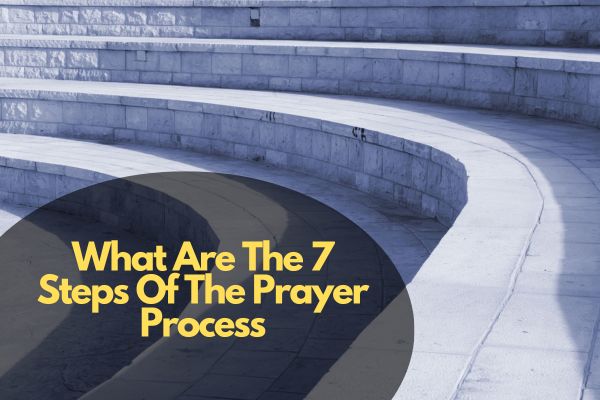Table of Contents Show
Prayer, a practice revered across cultures, serves as a profound conduit between humanity and the divine. This universal act holds immense significance as it transcends geographical and religious boundaries, offering solace, guidance, and a means of connection to something greater than ourselves. In exploring the transformative power of a structured prayer process, we look into the heart of this age-old practice, understanding its pivotal role in shaping individuals, fostering community bonds, and providing a framework for spiritual growth.
What Are The 7 Steps Of The Prayer Process
The 7 Steps of the Prayer Process, as articulated by Matthew Kelly, provide a structured and transformative approach to prayer that fosters a deep connection with the divine. The process begins with GRATITUDE, urging individuals to express personal thanks to God for the blessings in their lives. AWARENESS encourages self-reflection, prompting a review of moments when one was or wasn’t the best version of themselves.
SIGNIFICANT MOMENTS look into key experiences, fostering introspection. PEACE and FREEDOM guide individuals toward inner tranquility and spiritual liberation. Considering OTHERS encourages a focus on the well-being of those around us. CLOSING wraps up the prayer, emphasizing a holistic approach to spiritual growth. These steps collectively create a prayerful journey that transcends mere supplication, fostering self-awareness, gratitude, and a profound connection with the divine.
Step 1: Centering
Grounding Oneself in the Present Moment
The initial step of the prayer process beckons individuals to ground themselves in the present moment. In a world fraught with distractions, centering involves a deliberate pause, allowing individuals to shed the weight of past concerns and future anxieties. It’s an invitation to inhabit the present fully, anchoring the mind in the ‘now’ and fostering a sense of mindfulness.
Connecting with Inner Thoughts and Emotions
Once centered, the focus shifts inward, prompting individuals to connect with their inner thoughts and emotions. This introspective phase encourages an honest exploration of one’s mental and emotional landscape, fostering self-awareness and laying the foundation for a genuine, heartfelt connection during the prayer.
Step 2: Gratitude
Acknowledging Blessings and Positive Aspects of Life
Gratitude, the second step in this transformative journey, entails acknowledging the blessings and positive aspects of life. By consciously recognizing and appreciating the abundance, individuals cultivate a mindset of thankfulness. This practice not only shifts the focus from what might be lacking to what is present but also establishes a positive emotional baseline for the remainder of the prayer process.
Cultivating a Thankful Mindset
Cultivating a thankful mindset is not merely an expression of politeness; it’s a deliberate shift towards recognizing the beauty in life’s intricacies. Gratitude fosters contentment, resilience, and a deep appreciation for the interconnectedness of all things. As individuals express their thanks during this step, they pave the way for a more profound and enriching prayer experience.
Step 3: Reflection
Self-Examination and Introspection
Reflection, the third step, invites individuals into a realm of self-examination and introspection. This stage prompts an honest evaluation of one’s actions, motivations, and responses to life’s circumstances. It provides a space for individuals to confront their realities, fostering self-awareness and paving the way for personal growth.
Identifying Areas for Personal Growth and Improvement
Within the folds of reflection lies the opportunity to identify areas for personal growth and improvement. This critical aspect of the prayer process acts as a mirror, reflecting the strengths and weaknesses of an individual’s character. The willingness to confront and address areas needing improvement becomes a catalyst for positive transformation and spiritual evolution.
In traversing the initial steps of this structured prayer process, individuals embark on a journey that goes beyond the superficial. Centering, gratitude, and reflection serve as foundational pillars, setting the stage for a prayer experience that is not just ritualistic but a genuine, transformative dialogue with the divine.
Step 4: Supplication
Presenting Requests and Desires to a Higher Power
In the fourth step of the prayer process, supplication unfolds as individuals present their requests and desires to a higher power. This stage goes beyond a mere wishlist; it’s an intimate dialogue where one expresses their deepest longings, hopes, and even fears to the divine. The act of supplication recognizes the inherent human need for guidance, intervention, and divine support.
Expressing Vulnerability and Seeking Divine Guidance
Embedded within supplication is the act of expressing vulnerability and seeking divine guidance. It’s an acknowledgment of our limitations and an earnest plea for wisdom beyond our understanding. This step invites individuals to lay bare their hearts, trusting in the benevolence of a higher power to guide their paths and illuminate their journeys.
Step 5: Meditation
Engaging in Quiet Contemplation
Meditation, the fifth step, beckons individuals to engage in quiet contemplation. It’s a departure from the bustling noise of daily life, providing a sacred space for silence. In this stillness, individuals can attune themselves to the subtle whispers of the divine, fostering a deeper connection and understanding.
Focusing on Spiritual Principles and Wisdom
During meditation, the focus shifts to spiritual principles and wisdom. This intentional shift of attention allows individuals to immerse themselves in timeless truths, drawing inspiration from sacred texts, teachings, and personal revelations. It’s a deliberate alignment with spiritual insights that fuel personal growth.
Step 6: Affirmation
Speaking Positive Declarations into Existence
Affirmation, the sixth step, is a powerful declaration of positive truths. By speaking affirmations into existence, individuals participate in the co-creation of their realities. This step is not about wishful thinking but about aligning thoughts and words with divine principles, fostering an environment of positivity and faith.
Building a Foundation of Faith and Confidence
Beyond positive declarations, affirmation builds a foundation of faith and confidence. It’s a deliberate act of reinforcing beliefs in the divine’s benevolence, one’s inherent worth, and the interconnectedness of all things. This step serves as a cornerstone for a resilient, faith-filled life.
Step 7: Conclusion
Summarizing the Prayer Process
As the prayer journey reaches its conclusion, there’s a moment of summarization. This involves reflecting on the steps traversed, acknowledging the emotions experienced, and recognizing the divine presence throughout the process.
Emphasizing the Ongoing Nature of Spiritual Growth
The conclusion not only marks the end of a particular prayer session but underscores the ongoing nature of spiritual growth. It’s a reminder that the prayer process isn’t a one-time event but a continuous journey of evolution, self-discovery, and communion with the divine.
In navigating these concluding steps, individuals complete a comprehensive prayer process that encompasses supplication, meditation, and affirmation. This holistic approach not only addresses immediate needs but fosters a profound and enduring connection with the divine.
Conclusion
The 7-step prayer process we’ve explored encapsulates a transformative journey that transcends traditional supplication. Each step, from centering and gratitude to reflection, supplication, meditation, and affirmation, intricately weaves together a shade of spiritual growth. The significance of prayer across various cultures becomes evident as this structured process harmonizes the universal human experience of seeking connection with a higher power. Through centering, individuals ground themselves in the present, fostering a connection with inner thoughts and emotions.
Gratitude cultivates a thankful mindset, while reflection prompts self-examination and personal growth. Supplication deepens this connection by presenting desires and seeking divine guidance. Meditation provides a quiet space for contemplation, focusing on spiritual principles, and affirmation builds a foundation of faith and confidence. The conclusion of this prayer process is not just a culmination but a realization that spiritual growth is an ongoing, dynamic journey. By embracing these 7 steps, individuals embark on a continuous exploration of self, spirituality, and connection with the divine, fostering a profound sense of peace, purpose, and fulfillment in their lives.
FAQs
What are the seven steps of the prayer process?
The seven steps of the prayer process provide a structured framework for a meaningful prayer experience. These steps typically involve elements such as praise, confession, thanksgiving, and supplication. Understanding and following these steps can help individuals deepen their spiritual connection and communication with a higher power.
How do the seven steps of the prayer process enhance spiritual growth?
Engaging in the seven steps of the prayer process contributes to spiritual growth by fostering self-reflection, humility, and gratitude. Each step serves a specific purpose, such as acknowledging the greatness of a higher power, confessing shortcomings, expressing gratitude, and seeking guidance. This intentional approach to prayer encourages individuals to cultivate a more profound spiritual awareness and connection.
Can the seven steps of the prayer process be adapted to different religious traditions?
Yes, the seven steps of the prayer process are often adaptable to various religious traditions. While the specific content and wording of prayers may vary, the overarching principles of praise, confession, thanksgiving, and supplication are common across many faiths. Individuals from different religious backgrounds can personalize these steps to align with their beliefs and practices, making the prayer process a versatile and inclusive spiritual practice.







